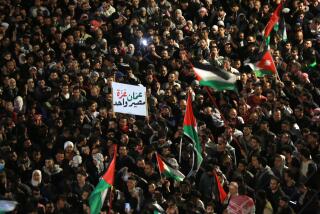Arab Leaders Ask Europeans to Help Broker Mideast Peace
- Share via
AMMAN, Jordan — Arab leaders complained Sunday of U.S. bias toward Israel and called on the European Union to act to bring balance to the search for lasting Middle East peace.
They won a sympathetic hearing from Italian Foreign Minister Susanna Agnelli, who is leading an EU delegation on a tour of Egypt, Jordan and Lebanon to discuss EU involvement in the peace process. Agnelli also said that Europeans have a better understanding of the Middle East than Americans do because of their proximity to the region.
“They can come with the whole of their power and try to make peace, which is a very good thing,” Agnelli told reporters after talks with Jordanian Prime Minister Karim Kabariti.
“I hope that they will always manage to do it, but I still think that we know the region better,” Agnelli added.
She said earlier in Cairo that Egyptian President Hosni Mubarak told the delegation of a sense in the Middle East “of injustice because perhaps from the part of the United States there has been too much bending toward Israel.”
Arab League Secretary-General Ahmad Esmat Abdel Meguid spoke of a “feeling of anger” at Israel’s bombardment of southern Lebanon during more than two weeks of cross-border fighting with Islamic Hezbollah fighters.
“We’re going to report that to our European partners and express what our feelings are--which are that we think the attitude of the world should be more balanced,” Agnelli said.
Also Sunday, the Israeli army said that faulty Israeli military maps were a central cause of the April 18 shelling of a U.N. camp at Qana in southern Lebanon in which about 100 refugees were killed.
Deputy military commander Matan Vilnai told a news conference, “The central mistake, which came out in army investigations afterward, was that the margins of safety [allowed by Israeli gunners] were inaccurate, because the exact location of the camp was off to the side, with respect to what we had on our maps.”
Vilnai said that the error in maps used by the army’s northern headquarters--a miscalculation that placed the camp about 300 feet from its actual location--was compounded by an inaccurate representation of the size and nature of the base.
“The measurements were such that in the natural dispersion of artillery, some of the shells, to our regret, entered the camp,” he said.
More to Read
Sign up for Essential California
The most important California stories and recommendations in your inbox every morning.
You may occasionally receive promotional content from the Los Angeles Times.










